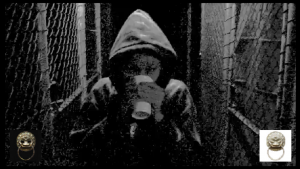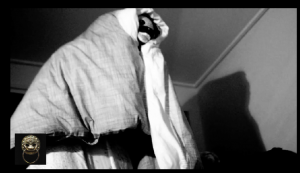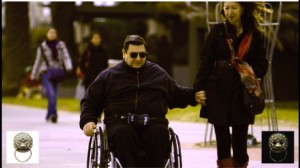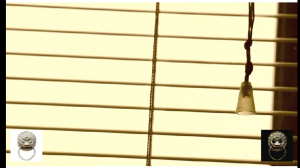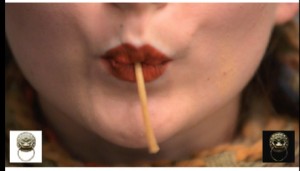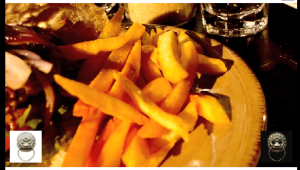Brainstorming…
Our group came up with an idea around autism, a disorder characterised by impaired social interaction, verbal and non-verbal communication. We were thinking to have footages in different camera angles or techniques like the fish-eye effect, low angle shot, fast- motion, etc. It is a bit hard to construct concepts of what to film. We are at the moment building video clips on the compulsive behaviours appeared in autism such as arranging objects in line. As well we are trying to show how autistic people express themselves; for example, with less eye-contact, very simple body movements. Another thing we have considered is using both black-and-white and coloured footages. We want to create the connection between the reality, which is coloured; and the things happened in autistic people’s minds, which will be in grey scaled. Here is one of the clip I took:Integrated Media 1
There are 27 posts filed in Integrated Media 1 (this is page 1 of 3).
Integrated Media 1 – Week 11 Symposium
1. Does the design of the interface force the users attention to follow certain lines of focus as opposed to others?
– think of the interface as a visual space that presents all relation and hierarchy in the work – it doesn’t show the lists of keywords, numbers of videos, etc.; what not to show is as important as what is shown – Korsakow is composed of thumbnails, videos and text, everything is basic – in Korsakow, it is more than just showing but asking viewers to explore on the creators’ behalf – the design is again similar to seduction; do not tell or explain things in the beginning, let them explore and find things out2. What are the key considerations when constructing a multilinear work?
– how to connect the video clips; what are the different layers and threads – think about the design not only in temporal but also a sense of spatial – how do I want it to end; is the work going to end or last forever – draw map of the relations until I start building, the direction or shape comes in the process of building it – learn to listen to the material – what material is being filmed; and in what kind of media form (e.g. visual or audio) – the smaller and more abstract material, the more possibilities to mix and match with other things – risk; it is taking risk to construct a thing because we have no idea what it will look like next, yet we may discover unexpected connections3. Luers talks about databases in K-Films working on relational knowledge, and as such you can replicate narrative film techniques like flashback and montage. However is this disregarding the K-Film’s intention of exploring non-narrative?
– ideas of using flashbacks because the past generates meanings – we can still explore small narratives in individual SNU – narrative film has a fixed timeline going on in it therefore it is easy to do flashback; Korsakow does not have a fixed timeline – montage is more like creating explicitly or implicitly a meaning between images“Humans of New York” blog
the storyboard: capturing the human of New York
This is a blog created by Brandon. He photographed many New Yorkers and collected quotes as well as short stories from them. The blog is displaying a collection of portraits and captions. To me, I find things become interesting when they involve people, all kinds of people. It is fun to notice how they act; and everybody has his reason behind, or even a big story to tell.
some random stuff
“If you eat me, you’re gonna gain weight, another year older, and a stomach ache.”
First Sketch Film
Week 5
http://www.embres.ca/exhibit/watchthefilm/
Korsakow film Ceci N’est Pas Embres by Matt Soar
This is a website Hannah mentioned in the tutorial. It is quite an inspiration in planning my first sketch film in an non-linear way of presentation. Matt’s K-film ‘Ceci N’est Pas Embres‘ is composed with three seasons of winter, spring and summer. Every clips in each group will have the same in- and out- keyword of that particular season. In order to link between three seasons, one clip within the group has an out- keyword of the next season. That is, for example, a clip in the winter group will have an in- keyword of winter that associates it with all other winter clips, yet its out- keyword is spring then viewer will move from winter grouping to the spring grouping.
As Matt Soar said, most of us, most of the time, used to think about things as a storytelling in a linear form with beginnings/ causes, middles and ends/effects. In making Korsakow film, clips are associated not in the traditional way of storytelling, but keywords which there isn’t a definite combination, instead various connection over time.
Making a random K-film sounds quite easy by using one keyword which links in- and out- of all video clips. All the clips will be associated with one another. Yet, creating a linear K-film is completely different. There are a designated start SNU and end SNU. Each clip will have a different in-keyword which is the out-keyword of the previous clip. That means, there will be a route when going through the film. As for a multi-linear K-film, I reckon it feels like touching on a bit randomness and a bit linearity. We need to put similar things together in a group and then find out the connection between various groups.
I found it quite interesting that how I as a viewer can click and go through the video clips without a single second of thought.
Sketch Essay
‘Lucid Dreaming’ (2011)
http://vogmae.net.au/classworks/2011/luciddreaming.html
I chose this Korsakow film titled Lucid Dreaming (2011) to study since I think the construction of a K-film is close to the idea of a lucid dreaming experience. Lucid dream is a kind of dream in which we become aware we are dreaming. I began to see a K-film – an exploration of assorted video clips – is quite similar to a dream sequence with fragmented and probably dissonant states in one’s mind. Lucid Dreaming (2011) is more likely an experimental piece. Rather than forming a narrative, it is performing a list of various dream-related clips. It composes of some abstract ideas, some objects, and atmosphere of places where most of them carry strong mood and emotions. This film focuses on the notion of dreaming, that is interesting to explore as well ambiguous yet enough to evoke feelings.
Interface
The interface is simple only with a big viewing screen that is the SNU window, and two previews. These two previews are placed on the right and left side at the bottom corner of the viewing screen. Instead of showing thumbnails of footages going to play, the two previews windows are displayed as two buttons with a door- knocker in black and white background respectively. I quickly related the two buttons to the distinction of nightmare and comforting dreams because of the background colours. I had this first impression of ‘rapping’ the door- knockers before I enter another space in this dream sequence. The centered SNU window has drawn all my attention while watching this K-film and made me feel like I am travelling among variety types of dreams of somebody.
Content
The opening clip is different everytime I start the K-film again. After several attempts on clicking on the two buttons, I realized that there is no multi-linear narrative and no cause-and-effect relationship between clips. I keep going through the clips and I found two grouping of dreams. They are terrifying dreams and pleasant dreams respectively. Within the group, most of the clips actually quite resemble each other closely. In the group of terrifying dream, that is nightmares, the clips are generated around gloomy and mysterious ambience. Clips included concrete objects like flipping of shadows, moving of frightening creatures and sudden appearance of unknown hand on a window, and abstract senses of being trapped in a car as well as escaping in car park. Most of the nightmare video clips have the common characteristic of using the grey or blue toned which trigger the feeling of fear and discomfort.
Besides, most of clips are slightly out of focus and don’t reveal the whole image of the object, in this case they create the sense of mysterious and creepy when viewers don’t have much awareness of where and what the film subject is. In contrary, the video clips group of pleasant dreams is with vivid images. They evolve a sense of loving and caring especially in the clip of a woman holding hands with a guy on wheelchair. The shared feature produced in the clips like sunshine, beach, waves, light stealing through shutter, pier, and the sky in evening is the sense of warm colours and spacious environment in a way they develop a state of sereneness and a gently calming effect.
Some clip contents are a bit hard to clarify which group they are in. For example, clips of food, running of tap water, a close-up shot of a mouth of a woman piping spaghetti and putting coins in a glass bottle are quite abstract. When viewing these clips, I found the sound of the clips has been emphasized. Like in the clips of food, there is surrounding noise of people talking and laughing so I related it to the pleasant dreams group. Yet the sound of piping spaghetti and the jingling sound made by the dropping coins are sort of disturbing therefore I put them in the nightmare group.
Pattern
Pattern making in K-film is to help make sense of all these seemingly unrelated video clips and meaning is aroused from the relationship between them. I tend to jump between the two buttons at first; just to try learning about the grouping of the clips. The patterns are emerged after my few trials on clicking the two buttons randomly. The video clips do not show obvious logical coherence at first. Later I understand the two grouping of dreams; I discovered all the clips are connecting to the themes and moods associated to nightmares and pleasant dreams. All videos in pleasant dreams are related to safe and peace and yet another mouse click may bring in a nightmare which acts as a disturbance. The film also demonstrates a pattern of familiarity and surrealism based on the nature of dreams – how I found the familiar sight in the dreams to give myself a tranquil moment or the disorienting quality in a terrifying dream I experience that upsets me.
How do the three combine to ‘mean’ and ‘do’
The video clips are like demonstrating the human consciousness when dreaming that possibly bouncing among all these mental pictures; in which they are either abstract or concrete. How I chose the sequence of watching the clips create a more personal experience and interpretation by clicking on the two door-knocker buttons. I discovered that when viewing the groups of pleasant dreams, by clicking the button in white background goes into the next clip in same group since the colour matches (I logically connected the button in white background to the strikingly bright images showing in the interface). When the clip showing in the interface shift to another group, the colour of the background of the button changes in corresponding to the video group and moves from right to left. This is how interface and pattern function in watching K-films over and over again. The button on the left always gives the next clip within its group, that is either showing all clips belongs to the pleasant dreams or nightmares while the button on the right acts as a disturbance, interrupted by moving to opposite group. That means every pleasant dream has been assigned to the correlative clips within the group of nightmare and vice versa. In additional, sometimes when the content of the clip becomes unclear, I rely on the left button to classify it into its group.
Watching this K-film is similar to looping around bit by bit the fragmentation in our dreams. The video clips are more like pieces in one of the many jigsaw puzzles in our mind which are never to be completed. After a clip of dream has been played once, it will no longer be shown again in this loop. It imitates the process of dreaming: one particular dream will only occur once in our mind during that particular period when we are dreaming. Even though people have recurring dreams but this recurring characteristic does not take place within a lapse of dreaming time. The dream may fall back to the same idea or nature of the dream but will not be the same.
Some inspirations

